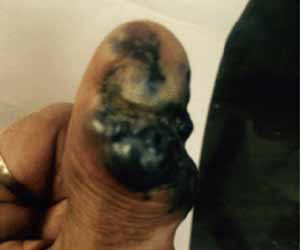- Home
- Editorial
- News
- Practice Guidelines
- Anesthesiology Guidelines
- Cancer Guidelines
- Cardiac Sciences Guidelines
- Critical Care Guidelines
- Dentistry Guidelines
- Dermatology Guidelines
- Diabetes and Endo Guidelines
- Diagnostics Guidelines
- ENT Guidelines
- Featured Practice Guidelines
- Gastroenterology Guidelines
- Geriatrics Guidelines
- Medicine Guidelines
- Nephrology Guidelines
- Neurosciences Guidelines
- Obs and Gynae Guidelines
- Ophthalmology Guidelines
- Orthopaedics Guidelines
- Paediatrics Guidelines
- Psychiatry Guidelines
- Pulmonology Guidelines
- Radiology Guidelines
- Surgery Guidelines
- Urology Guidelines
Nodular Melanoma in Diabetes patient mimicking diabetic gangrene: a case report

A case of a 60-year-old male type 2 diabetes mellitus patient presented with nodular melanoma mimicking diabetic gangrene was reported in the October issue of the Journal of Associations of Physicians of India (JAPI). He was presented at the OPD of Sarojini Naidu Medical College, Lucknow, with complaints of blackening of fingers & non-healing ulcer on his right thumb for the past 6 months.
According to the authors, he presented to OPD for his routine follow-up examination with complaints of a progressively worsening infected right thumb ulcer. The patient also admitted to having pain and foul-smelling discharge from the ulcer. The patient denied any tobacco or alcohol use. Physical examination was unremarkable except for an ulcer on the thumb of his right hand measuring 2 cm*3 cm with an ulcerated area at the base PIP of the thumb. The ulcer was necrotic, black with bleeding and minimal purulent drainage.
Read also: Golden drug SGLT2 Inhibitors may lead to Fournier Gangrene, confirms post marketing review
The patient was started on oral antibiotics with local wound care and surgical consultation obtained. The outpatient surgical evaluation revealed a black eschar with punctuate areas of bleeding after the removal of the eschar. The patient was admitted to the hospital for surgical debridement of the presumptive diabetic necrotic ulcer.
Laboratory studies including C-reactive protein (CRP) were within normal limits. The patient was a known case of type II DM for the last 6-7 years with good glycemic control on OHA. His Fasting blood sugar was 92 mg/dl & postprandial was 156 mg/dl. His liver and kidney functions were normal. Viral markers were negative. CXR and ultrasound abdomen were within normal limits. His HbA1C was 6.3% indicating excellent control of his diabetes. Radiographic studies of the hand showed soft tissue and bony involvement, however, there were no signs of osteomyelitis.
Read also: A rare case of Fournier’s Gangrene
In the operating room under careful examination, the edges of the lesion were irregular with hyperpigmentation highly suggestive of a malignancy. An excision biopsy with 2 mm margin was sent for the frozen section and pathology evaluation. The pathologic diagnosis was nodular malignant melanoma. The tumor had an ulcerated surface that permeated the papillary and reticular dermis with the permeation of subcutaneous tissue. A definitive procedure was subsequently performed that included en bloc amputation and wide excision of the previously excised melanoma along with sentinel lymph node biopsy after localizing the node with radioscintigraphy. The patient’s sentinel lymph node biopsy was positive for lymph node metastasis.
Based on the results they got from the test the authors concluded that this was a rare case of a nodular melanoma mimicking diabetic gangrene. Nodular melanoma is an invasive form of melanoma. Melanoma is a potentially serious skin cancer that arises from pigment cells (melanocytes). The lesion presents as a nodule (lump) that has been rapidly enlarging over the previous weeks to months.
The main risk factors for nodular melanoma are Increasing age, Previous invasive melanoma or melanoma in situ, Many melanocytic naevi (moles), Multiple (>5) atypical naevi (funny-looking moles), Fair skin that burns easily. Nodular melanoma may arise on any site but is most common on exposed areas of the head and neck. Nodular melanoma presents as a rapidly enlarging lump (over several weeks to months). The symptoms of nodular melanoma include: A) Larger size than most moles – >6 mm and often a centimeter or more in diameter at diagnosis B) Dome-shaped, often symmetrical firm lump C)Single color or variable pigmentation – most often black, red or skin-colored D) Smooth, rough, crusted or warty surface E) Ulceration or bleeding F) Itching or stinging. One-third of nodular melanomas are not pigmented. They lack the ABCD melanoma warning signs. (Asymmetry, Border irregularity, Colour variation, large diameter.
Read also: 70% skin breaks in diabetics can turn into cellulitis, say doctors
Malignant Melanoma Masquerading as Diabetic Gangrene, Prabhat Agarwal, Ashish Gautam, Manish Bansal, Rosmy Jose, Shalini Upadhyay. Available at japi.org

Disclaimer: This site is primarily intended for healthcare professionals. Any content/information on this website does not replace the advice of medical and/or health professionals and should not be construed as medical/diagnostic advice/endorsement or prescription. Use of this site is subject to our terms of use, privacy policy, advertisement policy. © 2020 Minerva Medical Treatment Pvt Ltd